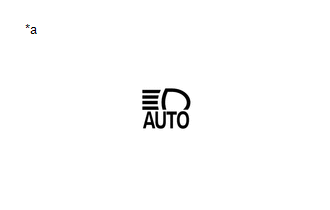- Inclement weather such as heavy rain, fog, sandstorms or snow.
- The temperature inside the vehicle is high.
- The taillights of a proceeding vehicle are obscured by snow, etc.
Lexus NX: Operation Check
OPERATION CHECK
AUTOMATIC HIGH BEAM SYSTEM OPERATION CHECK
(a) Check the operation of the automatic high beam indicator light.

| *a | Automatic High Beam Indicator Light |
NOTICE:
If the forward recognition camera cannot correctly recognize the front due to bad weather (dense fog, etc.) or obstructions, the automatic high beam indicator in the combination meter assembly may illuminate, and the automatic high beam system may not operate.
(1) Turn the power switch on (IG).
(2) Turn the headlight dimmer switch assembly (light control switch) to the AUTO or head position and the low beam headlights are on.
(3) Turn the headlight dimmer switch assembly to the low position.
(4) Turn the combination switch assembly (automatic high beam main switch) on.
(5) Check that the automatic high beam indicator comes on.
(b) Check the operation of the automatic high beam function.
(1) At night, when driving the vehicle with the automatic high beam system in standby mode, check that the high beams automatically turn on after a short delay when all of the following conditions are met:
- Vehicle speed is more than 34 km/h (21 mph).
- The area in front of the vehicle is dark.
- There are no oncoming vehicles with headlights on.
- There are no preceding vehicles with taillights on.
- There are few streetlights along the street ahead.
NOTICE:
The low beams may not change to high beams due to illumination from city lighting, signals, or billboards or due to reflective surfaces, such as signs or signboards.
(2) At night, when driving the vehicle with the high beams turned on by the automatic high beam system, check that the automatic high beam system turns off the high beams and returns to standby mode when any of the following conditions are met:
- Vehicle speed is less than 27 km/h (17 mph).
- The level of ambient light is higher than a specified threshold.
- There are oncoming vehicles with headlights on.
- There are preceding vehicles with taillights on.
- Light from streetlights ahead is higher than a specified threshold.
NOTICE:
-
Under the following conditions, the high beams may change to the low beams.
- There is interference from other illumination, such as city lighting, signals or billboards, or reflective
- There is interference from the fog lights of an oncoming vehicle
- A bicycle, etc. is detected
-
Under the following conditions, the high beams may not change to the low beams.
- Passing an oncoming vehicle on a curve
- Preceding or oncoming vehicle appears and disappears on a continuous curve
- Preceding or oncoming vehicle appears and disappears due to the median, roadside trees or other
- Another vehicle cuts in front of the vehicle
- Preceding or oncoming vehicle has no lights, has lights with unusual colors, or has very dim lights
(3) When any of the following conditions are met, the automatic high beam system will be canceled and the indicator light will turn off:
- The power switch is turned off.
- The light control switch is turned to any position except the AUTO or head position.
- The headlight dimmer switch assembly is moved to the high position.
- The combination switch assembly (automatic high beam main switch) is off.
(a) General Description
The automatic high beam system is a system that helps ensure visibility by automatically turning the high beams on and off. In addition, due to control limitations of the automatic high beam system, it may be necessary to manually turn the high beams on and off. For safety reasons, make sure to turn the high beams on and off manually according to the driving conditions.
(b) Conditions Unsuitable for Using Automatic High Beam System
Under the following conditions, the automatic high beam system might not detect other vehicles or lights correctly, or the high beams might cause glare or flash pedestrians or the occupants of other vehicles. Manual operation should be considered.
| Factor | Condition |
|---|---|
| Weather/Climate | |
| Front windshield | Refer to Front Camera System. |
| Forward recognition camera | Refer to Front Camera System. |
| Nearby vehicles or lights |
|
| Road conditions |
|
| Own vehicle |
|

.gif)
